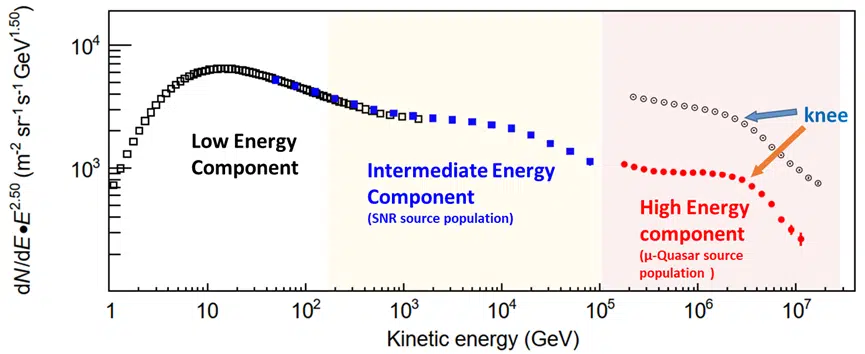Cosmic rays, high-energy particles that travel through space, have puzzled scientists for decades. One particular feature of their energy spectrum—the “knee”—has long remained a mystery. Recent breakthroughs, however, suggest that black holes may hold the key to understanding this phenomenon. Provided by the Chinese Academy of Sciences, a new study published in Science Bulletin offers compelling evidence that micro-quasars, systems powered by black holes, could be the source of this cosmic enigma.
Unveiling the Cosmic Ray “Knee”
For nearly 70 years, scientists have struggled to understand the peculiar feature of the cosmic ray spectrum known as the “knee.” This feature marks a sharp drop in cosmic ray intensity above 3 PeV, creating a distinct bend that scientists have speculated could indicate an acceleration limit in cosmic ray sources. While early theories pointed to supernova remnants as the likely culprits, they couldn’t fully explain the extreme energies observed at the knee.
However, in a recent study by the Chinese Academy of Sciences, researchers have uncovered evidence that micro-quasars—binary star systems containing a black hole—are the likely origin of these ultra-high-energy cosmic rays. The study, published in Science Bulletin, highlights how these black hole-driven systems generate powerful relativistic jets that accelerate particles to extreme energies, possibly beyond the knee’s threshold. This discovery shifts our understanding of cosmic ray origins and places black holes at the forefront of this fascinating astrophysical puzzle.
 The cosmic ray proton energy spectrum measured by LHAASO in “knee” region (red dots), along with the low-energy component measured by the space-borne AMS-02 experiment (black squares) and the intermediate-energy component measured by the space-borne DAMPE experiment (blue squares). (Image by LHAASO Collaboration)
The cosmic ray proton energy spectrum measured by LHAASO in “knee” region (red dots), along with the low-energy component measured by the space-borne AMS-02 experiment (black squares) and the intermediate-energy component measured by the space-borne DAMPE experiment (blue squares). (Image by LHAASO Collaboration)
Micro-Quasars: The Hidden Accelerators of the Milky Way
Micro-quasars, named for their similarities to quasars but on a much smaller scale, are some of the most enigmatic and powerful objects in the universe. These systems consist of a black hole and a companion star, with the black hole drawing material from the star, forming an accretion disk. As material falls into the black hole, it forms high-energy jets capable of accelerating particles to nearly the speed of light.
The recent research led by the Institute of High Energy Physics of the Chinese Academy of Sciences has identified several micro-quasars as significant cosmic ray accelerators. The study specifically focuses on systems like Cygnus X-1, SS 433, and V4641 Sgr, showing that these micro-quasars can propel particles to energies exceeding 1 PeV—surpassing the knee in the cosmic ray spectrum. By measuring the gamma rays emitted by these systems, the researchers were able to confirm that micro-quasars are not only accelerating cosmic rays, but are likely responsible for the high-energy components observed in the “knee” region.
Groundbreaking Techniques to Measure Cosmic Ray Spectra
One of the significant challenges in studying cosmic rays has always been the difficulty in accurately measuring their energy spectra, particularly in the “knee” region. Cosmic rays in this energy range are relatively sparse, and existing satellite-based detectors have struggled to collect enough data due to their limited coverage and sensitivity. Ground-based detectors, like the LHAASO (Large High Altitude Air Shower Observatory), have also faced challenges in distinguishing different types of cosmic rays due to atmospheric interference.
To overcome these challenges, LHAASO employed innovative multi-parameter measurement techniques, allowing for more precise detection of high-purity protons. These advances have enabled researchers to measure the cosmic ray energy spectrum with unprecedented precision. The resulting data revealed a complex structure, showing a “high-energy component” that was previously unanticipated. This breakthrough not only clarifies the origin of the knee but also helps scientists better understand the acceleration limits of cosmic ray sources within our galaxy.
The Role of Black Holes in Cosmic Ray Acceleration
What makes this discovery even more remarkable is the connection between black holes and cosmic ray acceleration. Prior to this study, many believed that supernova remnants, the explosive remains of dead stars, were the primary sources of high-energy cosmic rays. However, new findings suggest that these remnants cannot accelerate particles to the extreme energies seen beyond the knee.
Instead, it appears that black holes, particularly those in micro-quasars, possess a far higher acceleration capability. These systems not only create powerful jets but also generate extreme physical conditions that allow for the production of ultra-high-energy cosmic rays. The fact that researchers could directly link the knee in the cosmic ray spectrum to these black hole-driven systems marks a monumental shift in our understanding of the universe’s most mysterious and energetic objects.

